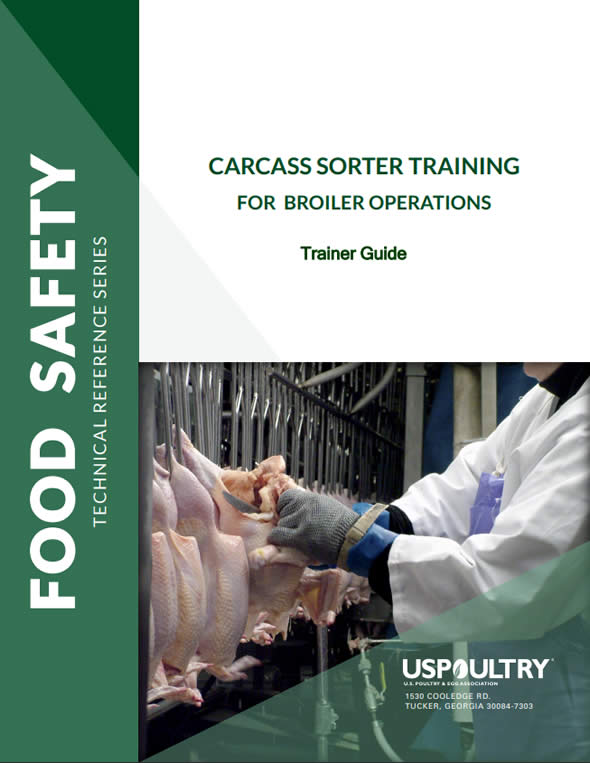- FOUNDATION
- |
- IPPE
- |
- PPFC
- |
- CONTACT
Technical Resources
USPOULTRY gathers technological information that aides implementation and improvements in the design and execution of food safety systems. Information is provided through technical references, multimedia resources, articles, meetings, and other educational events.
Technical Reference Series - HACCP Reassessment

This technical reference serves as a guide for those who are performing a HACCP reassessment or validation. This guide does not, and cannot, cover every circumstance. However, it does provide a framework for performing HACCP reassessments and validation activities. This guide is most applicable to HACCP systems that are already in place and is not intended to assemble a new HACCP plan from the ground up. If you have any questions or comments, please direct them to bstarkey@uspoultry.org.
To request access to this guide, go to the USPOULTRY Training Resources page under "Food Safety" and submit an access request. Note: Available to USPOULTRY Members Only
Technical Reference Series: NPIS Carcass Sorter Training

This technical reference guide serves as a guide to learn the main objectives of carcass sorting tasks under the New Poultry Inspection System (NPIS). Most recommendations and materials are derived from the USDA Food Safety and Inspection Service's own training for USDA inspectors. Industry experts collaborated in the development of this handbook. The handbook offers recommendations on how to train and learn the carcass sorting task in your operation. The training is available in English and Spanish. If you have any questions or comments, please direct them to mspencer@uspoultry.org.
To request access to this guide, go to the USPOULTRY Training Resources page under "Food Safety" and submit an access request. Note: Available to USPOULTRY Members Only
Technical Reference Series: Whole Genome Sequencing

Microbiome Analysis
Microbiome Analysis Using Next Generation Sequencing: Carcass Rinse and Swab Samples
This technical reference guide serves as a tool in the implementation of testing protocols for microbiome identification from carcass rinses or swabs using next genome sequencing (NGS) technology. This can be used as validation reference for food safety systems. NGS is useful to evaluate effectiveness of a process or an individual intervention as it relates to food quality (e.g. spoilage) or food safety (e.g. Salmonella or Campylobacter prevalence).
Industry experts collaborated in the development of this handbook. The handbook offers recommendations on how to train and learn the carcass sorting task in your operation.
Microbiome Analysis Using Next Generation Sequencing: APC Plates
This technical reference guide serves as a tool in the implementation of testing protocols for microbiome identification from Aerobic Plate Counts (APC) using a next genome sequencing (NGS) technology. This can be used as validation reference for food safety systems. APC is useful to evaluate effectiveness of a process or an individual intervention as it relates to food quality (e.g. spoilage). NGS can be used to identify specific populations of microorganisms in and can be used to observe its changes through the process.
To request access to this guide, go to the USPOULTRY Training Resources page under "Food Safety" and submit an access request. Note: Available to USPOULTRY Members Only
Webinars
WGS Webinar Series
This series contained five different webinar topics surrounding Whole Genome Sequencing (WGS) which occurred once a month from January to May of 2020. WGS is an increasingly valuable tool with a broad scope of applications from food safety management and surveillance to outbreak investigations.
Food Defense for Poultry and Egg Processors
After the Sept. 11, 2001 terrorist attacks a new emphasis in protecting key areas of the country regained attention. One of the interest areas was the food supply. Food is a prime target that can cause a significant disruption in our everyday lives. Poultry and Egg products are no exception. Poultry and egg products are one of the main sources of protein in the nation and it's available to a vast majority of the population within our borders. In the poultry industry, we should focus our attention on protecting our industry from the risk of a disruption in our everyday operations.
USPOULTRY has developed a food defense orientation program for poultry and egg processors. USPOULTRY's orientation program focuses on raising awareness on the potential risks that the industry faces and encourage employees to be active participants in protecting products in the workplace. The program offers a short orientation video for plant employees that will help you during training activities in your facility. It also includes a more detailed presentation for managers and key personnel directly involved in the design and execution of the plan. This presentation discusses why you should need to prepare a food defense program, what are the key elements should you take into account and explains why it is important to maintain your plan. The food defense orientation program also includes a resource guide to help you start designing your food defense program and it can help you find additional information that can help you improve your existing program.
Food defense programs normally incorporate existing programs like your food safety plan and your access control program. You will realize that several components of your program may be in place and your food defense plan adds additional meaning to what is already being done. Food defense programs along with the other food safety, employee safety, quality and security programs provide an additional layer of insurance to protect lives, jobs and your entire business.
To request access to this guide, go to the USPOULTRY Training Resources page under "Food Safety" and submit an access request.
If you have any questions or comments please direct them to mspencer@uspoultry.org.
General Info
Events & Meetings
People & Groups
- Affiliated States
- Air Cargo Committee
- Hen Council
- Industry Partners
- Poultry Protein & Fat Council
- USPOULTRY Foundation
